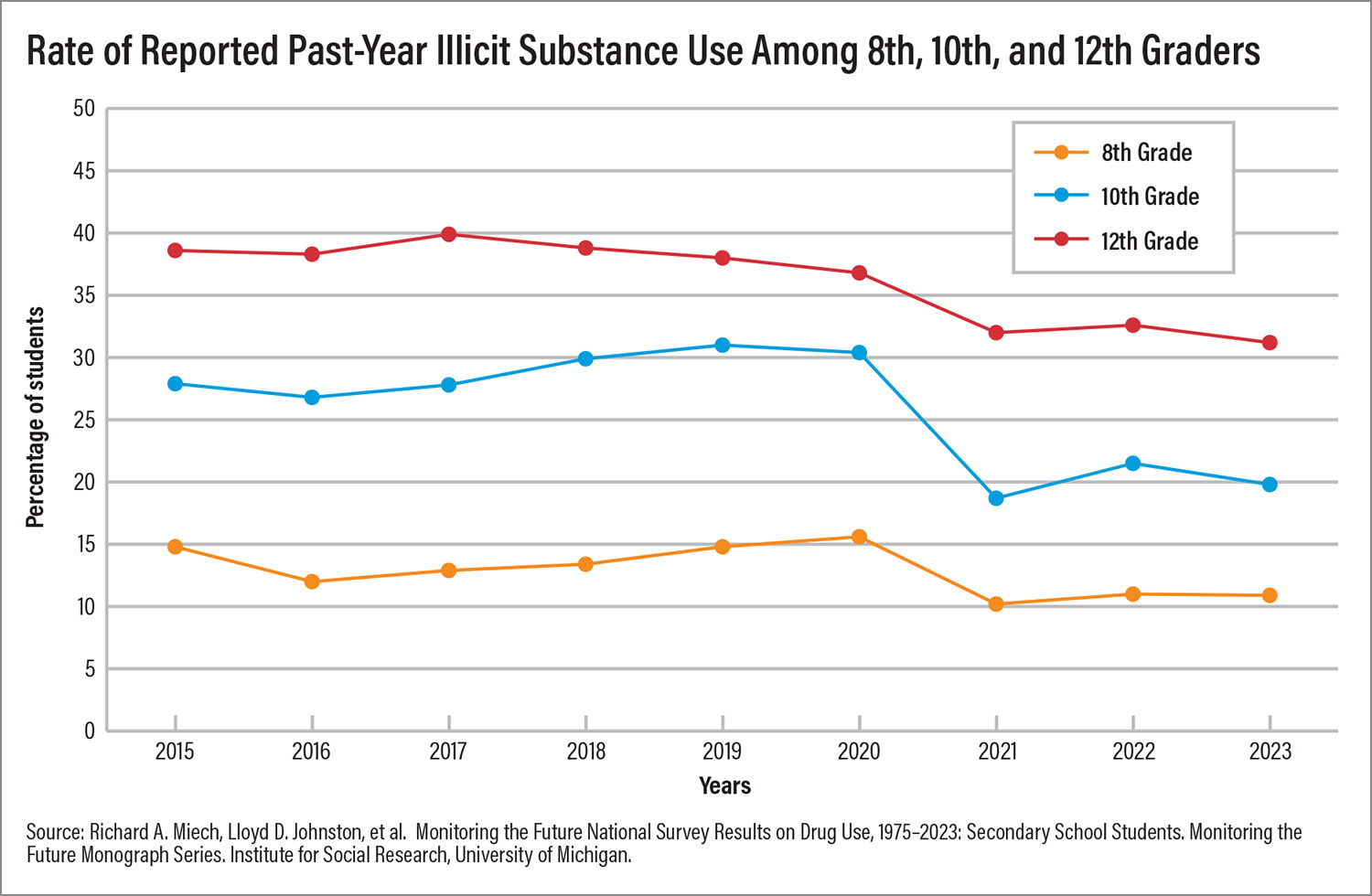After the COVID-19 pandemic and its associated school closures began in 2020, youth reported that they were using illicit substances significantly less, according to the
2023 Monitoring the Future survey. Among 12th graders, use of any illicit substances in the previous year fell from 36.8% in 2020 to 32% in 2021. Among 10th graders, the rate fell from 30.4% to 18.7%, while it fell from 15.6% to 10.2% among 8th graders.
Many schools have returned to in-person learning since the fall of 2021, and yet the percentage of students reporting any illicit substance use in 2023 has held steady at the lowered levels reported during the pandemic, according to the most recent Monitoring the Future survey. In 2023, 31.2% of 12th graders, 19.8% of 10th graders, and 10.9% of 8th graders reported any illicit substance use in the past year.
Monitoring the Future has tracked national substance use among 8th, 10th, and 12th graders at hundreds of schools across the country annually since 1975. It is conducted by the University of Michigan and funded by the National Institute on Drug Abuse (NIDA).
“This is encouraging news,” said Anish Dube, M.D., M.P.H., chair of APA’s Council on Children, Adolescents, and Their Families. “Peers have a huge influence on young people and the types of decisions they make. For better or worse, the pandemic limited the amount of time young people physically spent with their peers, and this may be at least one reason why we saw less risk-taking behavior among youth.”
Youth who responded to the survey most commonly reported drinking alcohol, vaping nicotine, and using cannabis in the past year. Compared with 2022 levels, past-year use of alcohol fell among 12th graders and remained stable for 10th and 8th graders. Nicotine vaping declined among 12th and 10th graders and remained stable among 8th graders. Finally, cannabis use remained stable among students in all three grades.
Simultaneously, however, in recent years the rate of fatal overdoses among youth has increased. A 2022
study published in
JAMA found that, beginning in 2020 until June 2021, adolescents experienced a greater relative increase in overdose mortality compared with the overall population. An
analysis by NIDA published last December found that the upward trends previously reported continued into the summer of 2022. Between the end of 2019 and the beginning of 2020, the rate of unintentional overdose deaths per 100,000 population among youth aged 15 to 19 rose from 0.89 to 1.32. The rate has not declined since that increase. In the summer of 2022, the rate was 1.63.
“In my own clinical experience, one of the biggest challenges has been the widespread availability of fentanyl and its derivatives, their lethality, and the ease with which they can be laced into other substances that young people are trying,” Dube said.
The illicit substances available now are highly addictive and can provide a quick and intense high, said Oscar Bukstein, M.D., M.P.H. That is part of the reason the rate of overdose deaths among adults is so high, and the same is likely true for youth.
“Young people in particular are usually novice drug users,” Bukstein pointed out. Just like younger adolescents are more likely to experience alcohol poisoning, youth who are using other illicit substances may similarly be unaware of the true danger of what they are using, he explained. Bukstein is a member of APA’s Council on Children, Adolescents, and Their Families and a professor of psychiatry at Harvard Medical School.
Bukstein also noted that, because Monitoring the Future surveys youth in schools, those who are not in school due to high-risk behaviors such as truancy or dropping out are less likely to be included. That means the survey may not capture youth who are at the highest risk for substance use. These youth need far more resources than are available to them, such as residential treatment for those who need more than intensive outpatient care, Bukstein said.
Overall, Bukstein is optimistic about Generation Z, he added. “I’ve noticed that there’s a greater sense among the general adolescent population that they want something out of life,” he said. “They know these substances are dangerous, that they are not going to get them where they want to go, and they don’t need them.” ■




